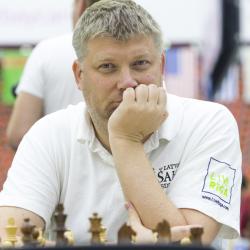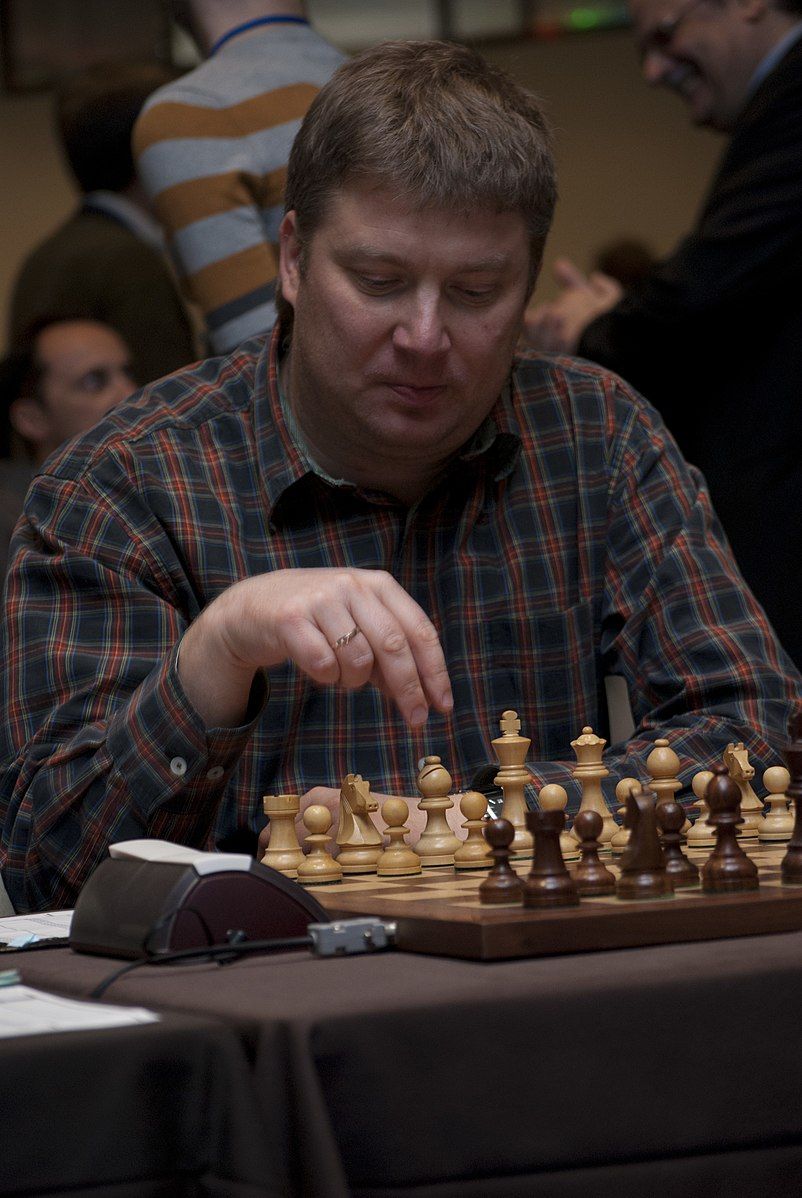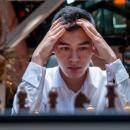GM Alexei Shirov

Bio
Alexei Shirov is a Latvian grandmaster who plays for Spain. In 1994 he was the number-two player in the world. Shirov defeated GM Vladimir Kramnik in a match in 1998 to become the challenger to GM Garry Kasparov for the classical world championship, but this match never took place.
Shirov has participated in 11 Olympiads and became the Spanish champion in 2002. Known for his brilliant tactical play, combinational vision, and spectacular sacrifices, Shirov has dazzled the chess world for three decades. His book Fire on the Board: Shirov's Best Games is a fan favorite and is mentioned in Chess.com's Top 10 Chess Books Every Chess Player Should Read.
- Style
- Early Career
- From Grandmaster To World-Class Player
- World Championship Challenger
- 1999-2000 FIDE World Championship
- Career After The World Championship Final
Style
Shirov is known as one of the greatest tacticians of all time—much like his fellow countryman and coach as a youth, former world champion GM Mikhail Tal. His style is unique in a world full of solid and positional grandmasters with universal playing styles. Shirov's creative imagination, fearless attacks, brilliant sacrifices, and clarity in difficult positions are noteworthy. It seems that Shirov feels comfortable in complicated positions with chaos on the chessboard and multiple pieces hanging!
Here is a game that displays Shirov's creativity and his ability to thrive in messy positions. Shirov offers his opponent, GM Loek van Wely, the exchange on move 14 (which van Wely wisely declines). Two moves later, Shirov offers more material with 16. Nd5, which must also be declined. After Shirov's 18. Bxd6, he has three pieces en prise!
In two more moves, Shirov plays the memorable 20. Ne7! that paralyzes Black completely. Van Wely resigns on move 25 with a mate in three on the board—an incredible game! Most chess players dream of playing a single game of this caliber in their lifetimes. For Shirov, this type of game was almost the norm!
Early Career
Shirov won the World U-16 Championship in 1988. He became an international master in 1989, and in 1990 he earned the grandmaster title. He finished in second place in the World Junior Championship in the same year. Even as a teenager, Shirov was a vicious attacker.
In the following game, Shirov wreaks havoc on the open board. He sacrifices a knight on move five, a bishop on move eight, and by move 14 all of his pieces are part of the attack while his opponent has developed only a knight and queen. After the beautiful stroke 15. Bd6!, it is all over and mate is delivered on move 17. A memorable attack that would make Paul Morphy, Adolf Anderssen or Tal proud!
Shirov began making a name for himself on the world stage in the early 1990s. He shared first place in the Lvov Zonal tournament in 1990. He won the 1991 Lloyds Bank Open ahead of a 129-player field consisting of many strong grandmasters. He also won the 1991 Biel International Chess Festival, ahead of GMs Evgeny Bareev, Ulf Anderssen, Joel Lautier, Larry Christiansen, Michael Adams, Viktor Gavrikov and Zdenko Kozul.
The following game from this period displays Shirov's incredible attacking talents. He sets his attack in motion with 15. Ng5 and sacrifices this knight on the next move. By move 22, all of Shirov's pieces are attacking and coordinated while his opponent's pieces are in disarray and his kingside is shattered and crippled by the mighty white pawn on g6.
On the next move, Shirov sacrifices his other knight and then offers a rook on the subsequent move (that cannot be captured due to mate on the h7-square). Seven moves later, Shirov has promoted a second queen—remember that powerful pawn on g6? His opponent resigned on move 32 while facing two queens on the eighth rank and mate in three on the board.
From Grandmaster To World-Class Player
By January 1992, Shirov had reached the world's top ten (and wouldn't leave this list for almost ten years). It wasn't long before the phenom was playing in world-class events against the world's best. He had a great start to the 1992 Biel International Chess Festival, leading the event with 3/4 and defeating the legendary GM Viktor Korchnoi. His second half of the tournament wasn't as strong, and he lost both games against GM Anatoly Karpov.
Shirov participated in the historical 1993 Linares Tournament. This event had nine of the top ten players in the world participating, and Shirov scored 8/13. He finished in fourth place behind Kasparov, Karpov, and GM Viswanathan Anand, but ahead of Kramnik and GMs Vassily Ivanchuk, Valery Salov, Alexander Beliavsky, Gata Kamsky, Bareev, Artur Yusupov, Jan Timman, Boris Gelfand, and Ljubomir Ljubojevic.
Shirov followed up the 1993 Linares tournament by winning the 1993 Munich tournament ahead of 11 strong grandmasters. In the 1993 Biel Interzonal Tournament, he finished half a point behind the qualifying players—narrowly missing a spot in the Candidates tournament.

Shirov continued his excellent play in the 1994 Linares Tournament. Much like the previous year, this tournament had nine of the top ten players participating. Shirov scored 8.5/13, placing second (alongside Kasparov) behind Karpov but ahead of many world-class players, including GMs Veselin Topalov, Kramnik, Anand, Kamsky, Ivanchuk, Gelfand, Judit Polgar and more. Around the time of this tournament Shirov became the second highest-rated player in the world on the FIDE rating list.
Here is an example of Shirov's play from this year where he defeats the top-10 player, Bareev, in only 15 moves! Shirov's shot with 15. Rad1 is remarkable. When is the last time you saw a top-ten player lose in 15 moves?
In 1995 Shirov played in his third Linares tournament and again had a strong performance. He scored 8/13, placing third (tied with Topalov) behind Ivanchuk and Karpov, but ahead of 10 world-class grandmasters. In 1996 Shirov finished in third place in the Tilburg Tournament behind winners GMs Jeroen Piket and Gelfand, but ahead of GMs Peter Leko, Karpov, Adams, Polgar, and several other world-class grandmasters.
In this game from the 1996 Tilburg Tournament, Shirov dismantles the strongest female player of all time, Judit Polgar. Shirov announces his intentions for an extremely sharp game with 10. g4 and then sacrifices a knight on move 13. A few moves later, Shirov sacrifices his other knight with 16. Nd5. After 20. Bxh7, Polgar has no kingside left and the game is decided.
Shirov shared first place with Topalov at the 1997 Madrid Tournament, ahead of GMs Nigel Short, Polgar, and six other world-class grandmasters. At the end of 1997, Shirov competed in the FIDE World Championship knockout tournament. The winner would be the challenger in the 1998 FIDE World Championship match against Karpov. Shirov was the seventh seed entering the tournament. He defeated GMs Julio Granda Zuniga, Gilberto Milos, and Vladimir Akopian to reach the quarterfinals (top eight). There Shirov lost to Anand (the eventual winner of the tournament).

Shirov began 1998 well with a 7.5/13 performance at the 1998 Hoogovens Tournament. He finished in third place on tiebreaks behind the winners Kramnik and Anand, but ahead of Topalov, Karpov, Gelfand, Polgar, Piket, Salov and several other grandmasters.
Shirov had another impressive performance in the 1998 Linares tournament. In a field comprised solely of top-ten players, he finished in clear second place with a score of 7/12. Anand won the tournament, but Shirov finished ahead of the impressive field of Kramnik, Kasparov, Svidler, Ivanchuk, and Topalov.
In the 1998 Linares tournament, Shirov played what many consider to be one of the strongest single moves ever played in a game! In a dull-looking, opposite-colored bishop endgame, Shirov shocked the world with 47...Bh3!!—a move that still confounds some chess engines.
After this stunning endgame piece sacrifice, Shirov's king walks from e6 to f5 and then all the way to b3 for the win. Shirov was in excellent form heading into the 1998 World Chess Championship Candidates match against Kramnik for the right to challenge Kasparov.
World Championship Challenger
It was Kasparov himself who suggested that a Kramnik-Shirov match could select a challenger for the World Championship, and in May and June of 1998 this match happened. The first three games were drawn, but Shirov defeated Kramnik in game four in an uninteresting, opposite-colored bishop endgame—Shirov had beaten Kramnik, the master of technical endgame play, at his own game! The next four games were also drawn, and Shirov was leading the match 4.5-3.5 heading into what would be the final game of the match.

In the ninth game, Kramnik played a sharper opening line against Kramnik's Grunfeld Defense (as he had gained no advantage with the white pieces in games one, three, and five in the Grunfeld main lines). Kramnik creates a large center-pawn structure at the price of delaying his development, but Shirov begins chipping away at it early. By the 16th move, Kramnik has a strong passed pawn on d6, but his king is still in the center of the board, and a few moves later Kramnik gives Shirov a chance to open up the position with 19...e4!
The position is on fire after Shirov's 21...Qb6, and Kramnik must give back a piece to stay alive. The resulting endgame after 37...Bxg2 shows that a rook is no match for a bishop and three connected passed pawns. Shirov won the ninth game and the match, earning the right to challenge Kasparov for the world championship.
Negotiations began for the Kasparov-Shirov world championship match, but funding was never secured, and Shirov never got to face Kasparov for the title. Would Shirov ever have another shot at a world title?
1999-2000 FIDE World Championship
In 1999 Shirov was the number-two seed in the FIDE World Championship knockout tournament. He defeated GMs Ivan Sokolov, Milos, and Short to reach the quarterfinals (top eight). Shirov (like all of the top seeds) was upset in the quarterfinals by GM Liviu-Dieter Nisipeanu.
He placed third in the 2000 Linares tournament, behind Kramnik and Kasparov and tied with the rest of the field of Anand, Leko and recently crowned FIDE World Champion GM Alexander Khalifman. He finished in shared second place (with GM Loek Van Wely) behind Gelfand in the 2000 Rubinstein Memorial Tournament.

Entering the 2000 FIDE World Championship knockout tournament, Shirov was the fourth seed. He defeated GMs Alexander Onischuk, Mikhail Gurevich, and Gelfand before reaching the quarterfinals. Shirov defeated Bareev in the quarterfinals and GM Alexander Grischuk in the semifinals to face Anand in the final. Shirov had earned another shot at a world championship!
Unfortunately for Shirov, Anand won their matchup easily with a 3.5/4 score, and Anand was crowned FIDE world champion.
Life After The World Championship
Shirov continued to play in (and win) many tournaments after the 2000 FIDE World Championship. In 2002 Shirov won the Spanish Championship ahead of GM Franciso Vallejo Pons and many other grandmasters. He won the 2003 Hrokurinn round-robin tournament ahead of Korchnoi, Adams and seven other strong grandmasters. In 2004 Shirov won the Bosnian International Tournament one and a half points ahead of the field and won the Paul Keres Memorial Tournament in both 2004 and 2005.
He shared first with GM Peter Heine Nielsen at the Smartfish Masters in Norway in 2005 and won the 2005 Canadian Open. He shared first place in the 2005 Gibraltar Masters tournament with GMs Levon Aronian, Kiril Georgiev, Emil Sutovsky, and Zahar Efimenko. In 2009 Shirov won the M-Tel Masters tournament ahead of GMs Magnus Carlsen, Topalov, Ivanchuk and others.

In the following classic Shirov game from 2008, he sacrifices multiple pieces in pursuit of the enemy king. His opponent does his best to play cautiously and solidly out of the opening, but the more White tries to keep the position simple, the harder Shirov tries to complicate matters. He first shows his aggressive intent by castling queenside on move 13. The real fun begins with the first sacrifice of 20...Rxg2+!
Over the next 11 moves, Shirov forces the white king from g1 all the way to c1 before his opponent resigns. Another gorgeous attacking example from Shirov!
In the 2010 Corus Tournament, he finished in shared second place (with Kramnik) behind Carlsen, but ahead of GMs Anand, Hikaru Nakamura, Sergey Karjakin, Ivanchuk, Leko, Fabiano Caruana, and others. In the following more recent game, Shirov displays a slower attack against the young GM Vladislav Artemiev. Shirov wins the bishop pair out of the opening, but a long and protracted maneuvering segment of the games occurs. On move 23, Shirov gains space on the kingside with g4, and the h-file is opened up on move 27.
Shirov slowly continues building his attack and thwarting Black's counterplay. After 41. Rbh1, Shirov has set up all of his heavy pieces on the h-file, and his opponent resigns 10 moves later.

After the collapse of the Soviet Union, Shirov represented Latvia from 1991 until 1995, when he switched federations to Spain. He returned playing for Latvia in 2011, but in 2018 he again made the switch and currently plays for Spain.
Still a very strong grandmaster, Shirov continues his excellent play even 20 years after his last shot at a world title. He scored 5.5/11 in the 2019 FIDE Chess.com Grand Swiss Tournament in the Isle of Man, where he played against Caruana, Carlsen, and Grischuk. Shirov finished in 39th place out of 207 competitors in the 2019 World Rapid Championships with a 9/15 score. In 2020 Shirov participated in the Nutcracker Match of the Generations, scoring 6.5/12.


